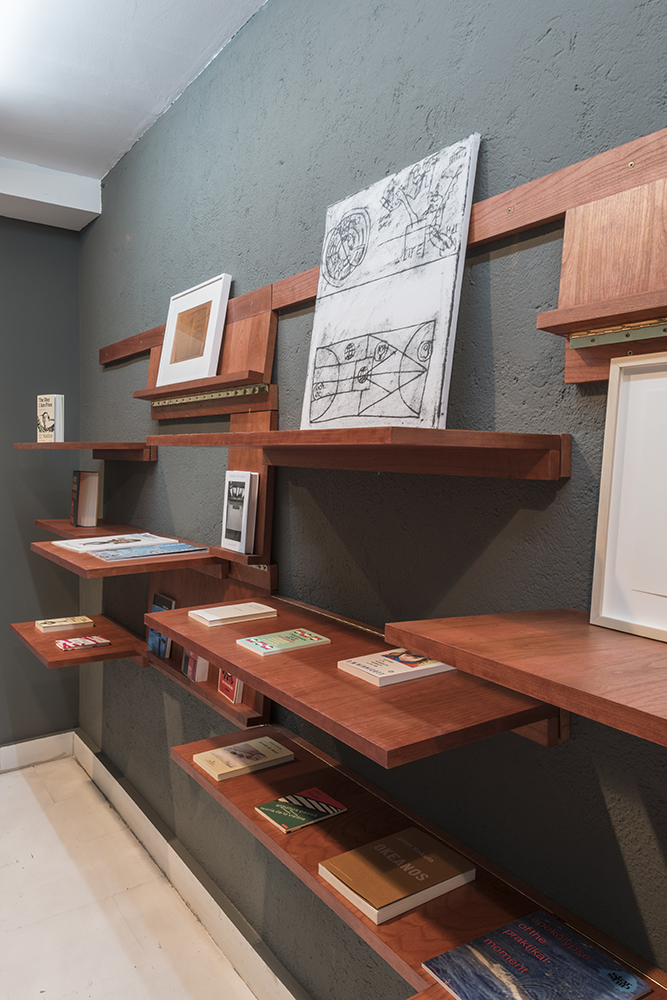Indirection and obliqueness are the constants, writes George Stolz
Roughly halfway through Rosa Barba’s Aggregate States of Matter (2019) – the stunning film installation that forms this show’s centrepiece – is a centrally framed shot of a woman. It’s a spare, almost classical portrait: a three-quarters, head-and-shoulders pose, set against the vast Peruvian altiplano, or Andean Plateau, which lies below and beyond. As the camera circles to address her face-on, she raises her eyes and looks impassively into its lens while the wind lifts wisps of her hair. The slight creases in the skin of her face find echoes in the folds of the terrain beyond, so that she seems not only to be in front of but also within and even of the landscape itself. And the film then moves on.
In keeping with the film’s deft, almost dreamlike structuring, no information is offered regarding who this woman is or why she is portrayed with such tender immediacy. External sources tell us, however, that she served as translator between Barba and the local Quechua people during the film’s onsite production. Thus her presence in the film, while brief, might be seen as emblematising the essential role of translation in the works here and in Barba’s transdisciplinary practice in general; an expanded kind of translational process, less concerned with relaying content itself from one artistic format to another than with capturing, assimilating and ultimately revealing, often in an indirect fashion, the shape-giving impulses below the surface of such content.
Aggregate States of Matter is a 20-minute study of a remote section of the Peruvian Andes, from Lake Titicaca to the peaks of the Cordillera Blanca. It is decidedly not a conventional documentary – it is far too elliptical and nonnarrative for that – yet neither is it inaccessible. To the contrary: the film’s layering of images and voices of the Quechua people, intimacy with its human subjects, breathtaking aerial footage and overarching gentle simplicity are as seductive as they are hypnotic. In the process, Barba succeeds, with remarkable efficiency, in conveying (ie translating to film) a sense of the land, the life it supports and the people who inhabit it; she also conveys, with equal economy, the terrifying changes affecting all of these as the mountain glaciers melt and retreat. (“Cambio climático”, or climate change in Spanish, can be discerned within the film’s recorded conversations, which otherwise take place in Quechua.) What is revealed is all the more powerful for being revealed obliquely, without stridency, as something that is, again, not only in but of the landscape itself.
Formally distinct yet sharing a certain methodological approach, another work in the exhibition – Liberties (2020) – consists of a pair of undulating wall-hanging sculptures cast in wax (the show also included language-based prints reminiscent of concrete poetry, a sound installation and a small librarylike installation of Barba’s books and artworks by her colleagues.) Within Liberties, small wax letters seem to emerge and flow downward, as if unfurling; at the same time, the densely textural work is reminiscent of organic material, of a geological eruption and crumbling (not unlike the glacier in the nearby film). This morass of words is drawn directly from Susan Howe’s 1980 poem ‘The Liberties’, so that what is at work is a kind of ekphrasis, a re-expression of a given artwork in a different medium. But here the shift is not from visual into verbal form but from the verbal to the sculptural. And more crucially, Barba’s reworking of Howe’s poem is utterly removed from an impulse towards illustration or even interpretation, but rather pushes – outwardly, sculpturally – towards something generative in its own right, like a seismic outcropping in a landscape of language.
Rosa Barba, Turn and Wind, Parra & Romero, Madrid, 26 February – 4 April 2020
From the April 2020 issue of ArtReview
